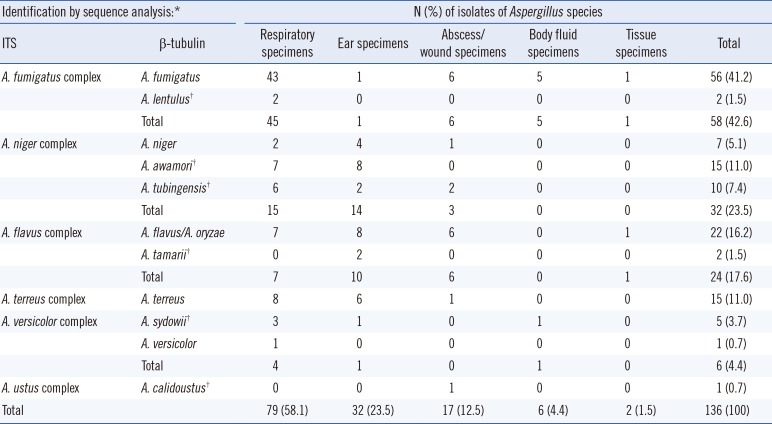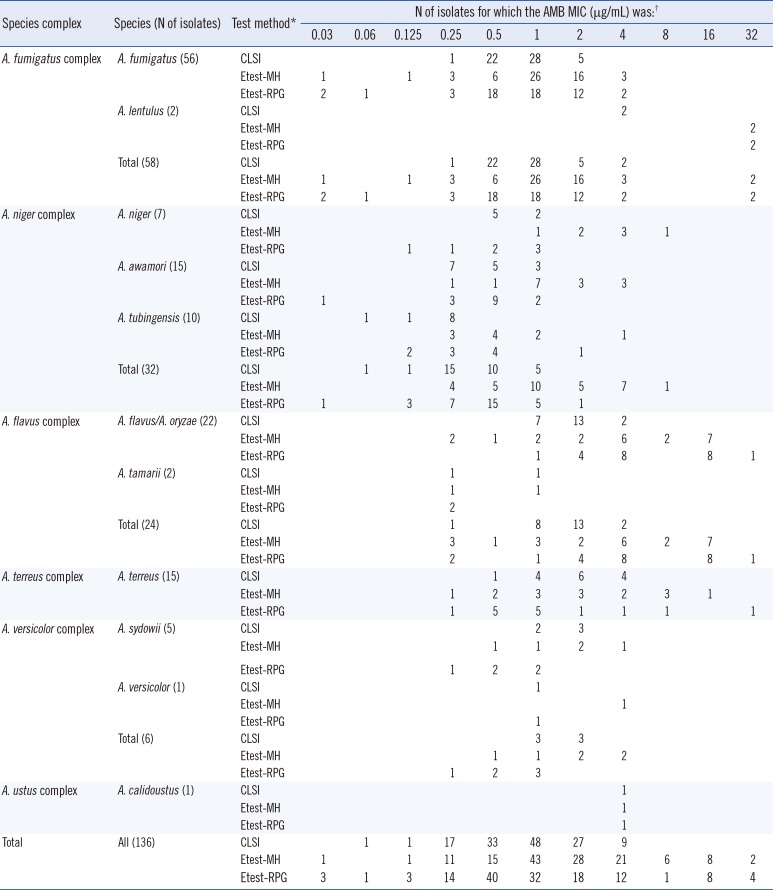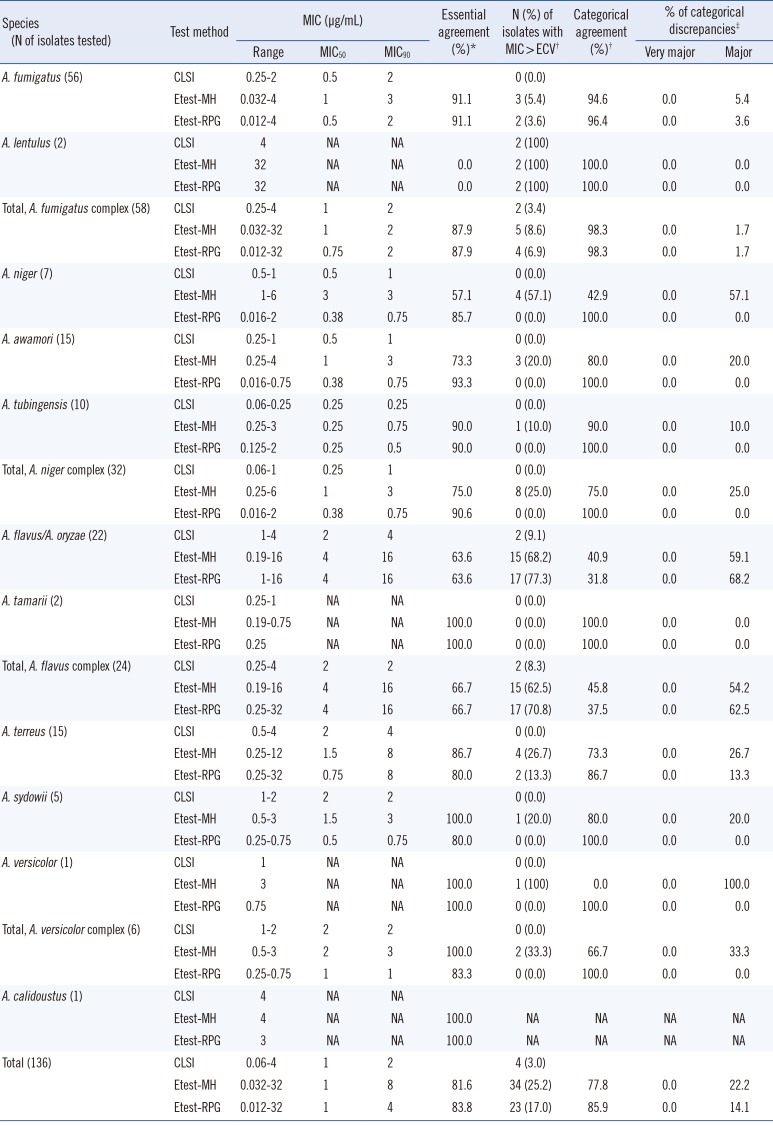1. Arendrup MC. Update on antifungal resistance in
Aspergillus and
Candida. Clin Microbiol Infect. 2014; 20(Suppl 6):42–48. PMID:
24372701.
2. Alastruey-Izquierdo A, Mellado E, Cuenca-Estrella M. Current section and species complex concepts in
Aspergillus: recommendations for routine daily practice. Ann N Y Acad Sci. 2012; 1273:18–24. PMID:
23230833.
3. Balajee SA, Nickle D, Varga J, Marr KA. Molecular studies reveal frequent misidentification of
Aspergillus fumigatus by morphotyping. Eukaryot Cell. 2006; 5:1705–1712. PMID:
17030996.
4. Balajee SA, Gribskov J, Brandt M, Ito J, Fothergill A, Marr KA. Mistaken identity: Neosartorya pseudofischeri and its anamorph masquerading as
Aspergillus fumigatus. J Clin Microbiol. 2005; 43:5996–5999. PMID:
16333088.
5. Balajee SA, Houbraken J, Verweij PE, Hong SB, Yaqhuchi T, Varga J, et al.
Aspergillus species identification in the clinical setting. Stud Mycol. 2007; 59:39–46. PMID:
18490954.
6. Lass-Flörl C, Kofler G, Kropshofer G, Hermans J, Kreczy A, Dierich MP, et al. In-vitro testing of susceptibility to amphotericin B is a reliable predictor of clinical outcome in invasive aspergillosis. J Antimicrob Chemother. 1998; 42:497–502. PMID:
9818749.
7. Van Der Linden JW, Warris A, Verweij PE.
Aspergillus species intrinsically resistant to antifungal agents. Med Mycol. 2011; 49:S82–S89. PMID:
20662634.
8. Espinel-Ingroff A, Cuenca-Estrella M, Fothergill A, Fuller J, Ghannoum M, Johnson E, et al. Wild-type MIC distributions and epidemiological cutoff values for amphotericin B and
Aspergillus spp. for the CLSI broth microdilution method (M38-A2 document). Antimicrob Agents Chemother. 2011; 55:5150–5154. PMID:
21876047.
9. Kim MN, Shin JH, Sung H, Lee K, Kim EC, Ryoo N, et al.
Candida haemulonii and closely related species at 5 university hospitals in Korea: identification, antifungal susceptibility, and clinical features. Clin Infect Dis. 2009; 48:e57–e61. PMID:
19193113.
10. Al-Wathiqi F, Ahmad S, Khan Z. Molecular identification and antifungal susceptibility profile of
Aspergillus flavus isolates recovered from clinical specimens in Kuwait. BMC Infect Dis. 2013; 13:126. PMID:
23496810.

11. Clinical and Laboratory Standards Institute. Reference method for broth dilution antifungal susceptibility testing of filamentous fungi. Approved standard, 2nd ed. M38-A2. Wayne, PA: Clinical and Laboratory Standards Institute;2008.
12. Shin JH, Kim MN, Jang SJ, Ju MY, Kim SH, Shin MG, et al. Detection of amphotericin B resistance in
Candida haemulonii and closely related species by use of the Etest, Vitek-2 yeast susceptibility system, and CLSI and EUCAST broth microdilution methods. J Clin Microbiol. 2012; 50:1852–1855. PMID:
22442324.
13. Pfaller MA, Messer SA, Motyl MR, Jones RN, Castanheira M.
In vitro activity of a new oral glucan synthase inhibitor (MK-3118) tested against
Aspergillus spp. by CLSI and EUCAST broth microdilution methods. Antimicrob Agents Chemother. 2013; 57:1065–1068. PMID:
23229479.
14. Perrone G, Stea G, Epifani F, Varga J, Frisvad JC, Samson RA.
Aspergillus niger contains the cryptic phylogenetic species
A. awamori. Fungal Biol. 2011; 115:1138–1150. PMID:
22036292.
15. Lass-Flörl C, Alastruey-Izquierdo A, Cuenca-Estrella M, Perkhofer S, Rodriguez-Tudela JL. In vitro activities of various antifungal drugs against Aspergillus terreus: global assessment using the methodology of the European committee on antimicrobial susceptibility testing. Antimicrob Agents Chemother. 2009; 53:794–795. PMID:
19064891.
16. Arendrup MC, Cuenca-Estrella M, Lass-Flörl C, Hope WW. European Committee on Antimicrobial Susceptibility Testing Subcommittee on Antifungal Susceptibility Testing (EUCAST-AFST). EUCAST technical note on Aspergillus and amphotericin B, itraconazole, and posaconazole. Clin Microbiol Infect. 2012; 18:E248–E250. PMID:
22540149.

17. Lass-Flörl C, Griff K, Mayr A, Petzer A, Gastl G, Bonatti H, et al. Epidemiology and outcome of infections due to
Aspergillus terreus: 10-year single centre experience. Br J Haematol. 2005; 131:201–207. PMID:
16197450.
18. Balajee SA, Kano R, Baddley JW, Moser SA, Marr KA, Alexander BD, et al. Molecular identification of
Aspergillus species collected for the Transplant-Associated Infection Surveillance Network. J Clin Microbiol. 2009; 47:3138–3141. PMID:
19675215.
19. Steinbach WJ, Marr KA, Anaissie EJ, Azie N, Quan SP, Meier-Kriesche HU, et al. Clinical epidemiology of 960 patients with invasive aspergillosis from the PATH Alliance registry. J Infect. 2012; 65:453–464. PMID:
22898389.

20. Szekely A, Johnson EM, Warnock DW. Comparison of E-test and broth microdilution methods for antifungal drug susceptibility testing of molds. J Clin Microbiol. 1999; 37:1480–1483. PMID:
10203509.

21. Meletiadis J, Mouton JW, Meis JF, Bouman BA, Verweij PE. Comparison of the Etest and the sensititre colorimetric methods with the NCCLS proposed standard for antifungal susceptibility testing of
Aspergillus species. J Clin Microbiol. 2002; 40:2876–2885. PMID:
12149345.
22. Badiee P, Alborzi A, Moeini M, Haddadi P, Farshad S, Japoni A, et al. Antifungal susceptibility of the
aspergillus species by Etest and CLSI reference methods. Arch Iran Med. 2012; 15:429–432. PMID:
22724880.
23. Ozkutuk A, Ergon C, Metin DY, Yucesoy M, Polat SH. Comparison of disk diffusion, E-test and broth microdilution test in determination of susceptibility of
Aspergillus species to amphotericin B, itraconazole and voriconazole. J Chemother. 2008; 20:87–92. PMID:
18343749.
24. Colozza C, Posteraro B, Santilli S, De Carolis E, Sanguinetti M, Girmenia C. In vitro activities of amphotericin B and AmBisome against
Aspergillus isolates recovered from Italian patients treated for haematological malignancies. Int J Antimicrob Agents. 2012; 39:440–443. PMID:
22429723.
25. Barchiesi F, Spreghini E, Sanguinetti M, Giannini D, Manso E, Castelli P, et al. Effects of amphotericin B on
Aspergillus flavus clinical isolates with variable susceptibilities to the polyene in an experimental model of systemic aspergillosis. J Antimicrob Chemother. 2013; 68:2587–2591. PMID:
23794598.







 PDF
PDF ePub
ePub Citation
Citation Print
Print


 XML Download
XML Download